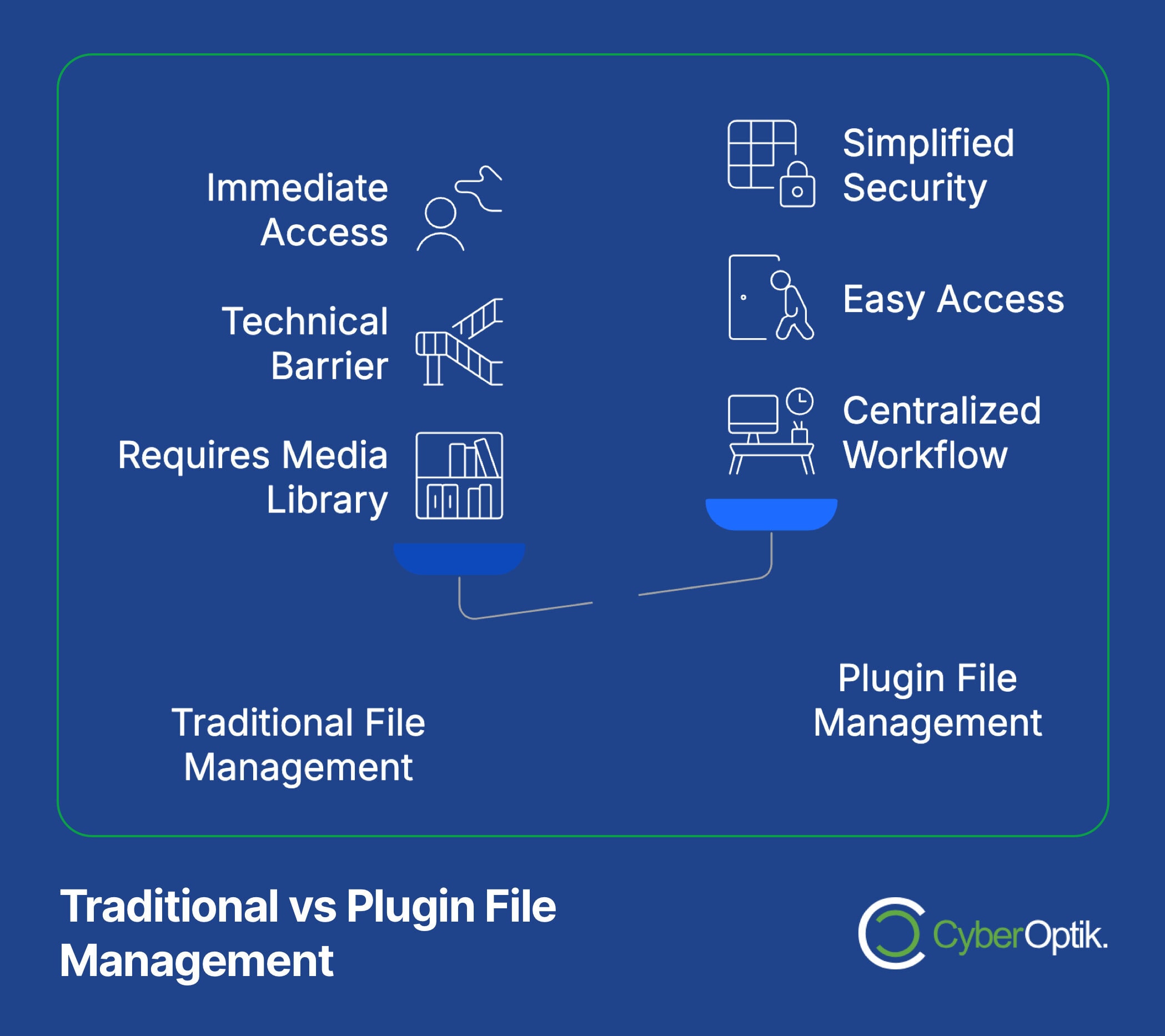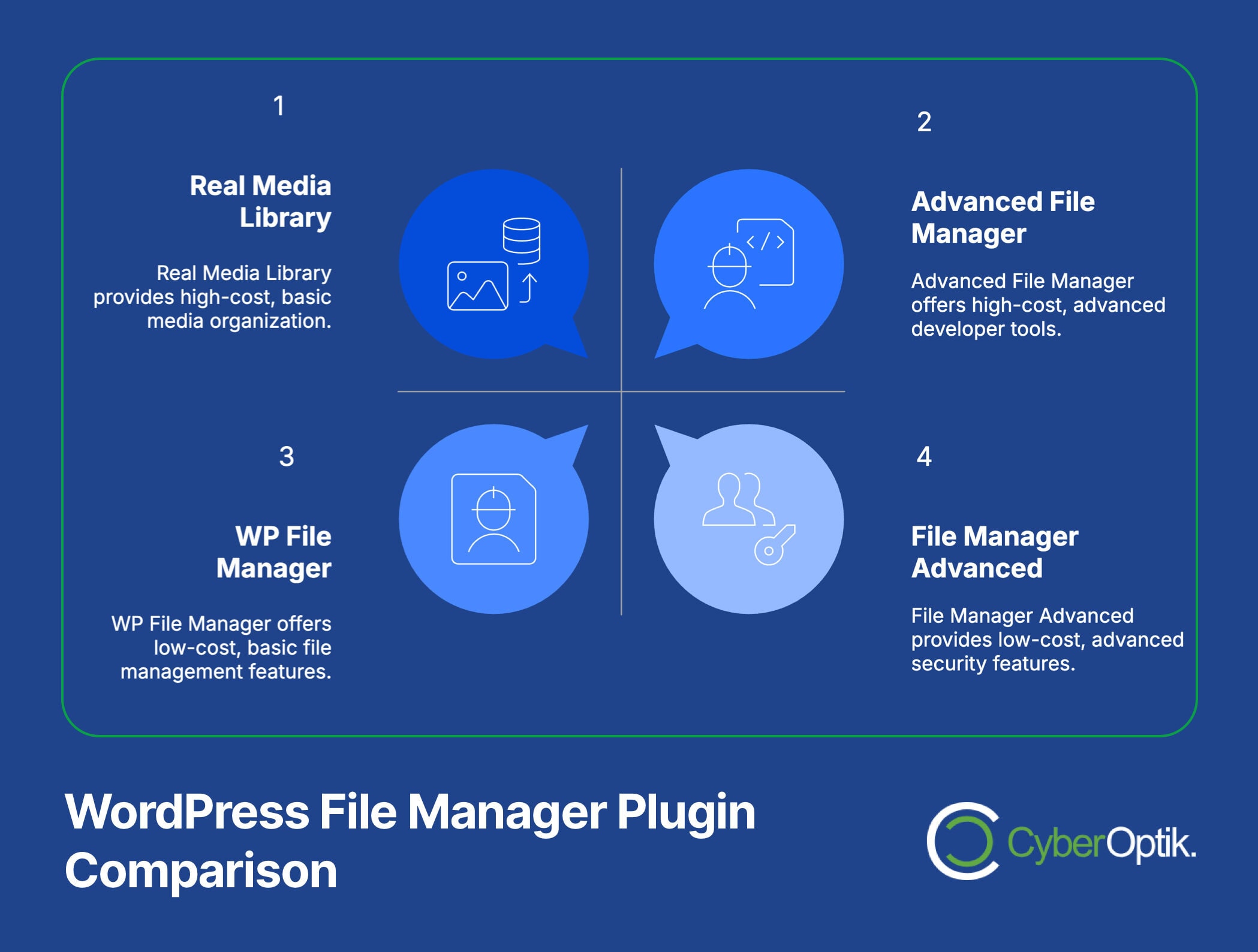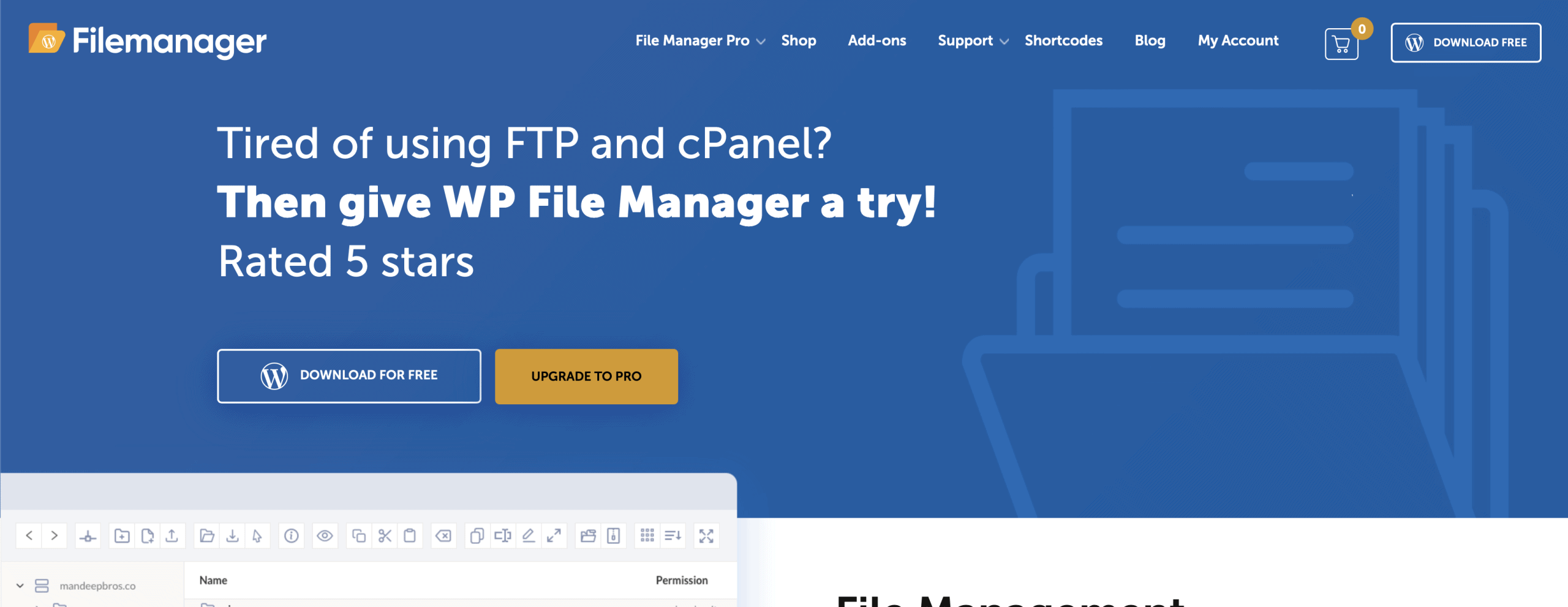Managing files is a critical part of maintaining a WordPress website. As business owners juggle multiple responsibilities, efficient file management often gets overlooked until problems arise. Accessing, organizing, and modifying files directly through your WordPress dashboard can significantly streamline your website management process and prevent future headaches.
At CyberOptik, we regularly help Chicago businesses optimize their WordPress websites for better performance and easier management. One of the most common challenges we see is inefficient file management, which can lead to disorganization, security vulnerabilities, and wasted time.
WordPress powers 43.6% of all websites globally, making it the most popular content management system by a significant margin.
In this comprehensive guide, we’ll explore the best file manager plugins for WordPress, their key features, security considerations, and how to choose the right one for your specific business needs. Whether you’re managing a small business website or a complex e-commerce platform, proper file management will save you time and prevent costly mistakes.

Understanding WordPress File Management
Before diving into specific plugins, it’s essential to understand what file management entails in WordPress and why standard options may not be sufficient for business websites.
The Basics of WordPress File Structure
WordPress organizes files in a specific structure that includes themes, plugins, uploads, and core system files. By default, WordPress provides limited file management capabilities through the Media Library, which only handles media files like images, videos, and documents uploaded through the content editor.
For anything beyond basic media management, website owners traditionally need to use FTP (File Transfer Protocol) clients or cPanel file managers provided by hosting companies. This approach creates several challenges:
- It requires additional software and technical knowledge
- It demands separate login credentials
- It creates a disconnected workflow from your WordPress dashboard
- It increases the risk of accidental file modifications
Why Efficient File Management Matters
Proper file management directly impacts your website’s:
Performance: Organized files and optimized media improve loading times
Security: Proper file permissions and monitoring prevent unauthorized access
Maintenance: Easy access to theme and plugin files simplifies updates and troubleshooting
Content workflow: Streamlined file operations enhance content creation processes
According to research, WordPress users publish approximately 70 million new posts monthly.
Benefits of File Manager Plugins
File manager plugins extend WordPress’s native capabilities in ways that create significant advantages for website owners. These tools bridge the gap between basic WordPress functionality and full server access.
Centralized Dashboard Access
File manager plugins integrate directly into your WordPress dashboard, eliminating the need to switch between different applications or interfaces. This centralization creates a seamless workflow where you can manage all aspects of your website from one location.
| Task | Without File Manager Plugin | With File Manager Plugin |
|---|---|---|
| Upload media files | WordPress Media Library | WordPress Dashboard |
| Access theme files | FTP Client/cPanel | WordPress Dashboard |
| Modify plugin files | FTP Client/cPanel | WordPress Dashboard |
| Manage file permissions | FTP Client/cPanel | WordPress Dashboard |
| Create/edit text files | External editor + FTP | WordPress Dashboard |
This integrated approach saves time and reduces the technical barriers that often prevent business owners from efficiently managing their websites.
Enhanced File Operations
File manager plugins expand WordPress’s native capabilities by adding functions like:
- Drag-and-drop file uploading and organization
- Bulk file operations (move, copy, delete, rename)
- File compression and extraction
- File editing with syntax highlighting
- File permission management
- Search functionality across all directories
These features significantly reduce the time required for common file management tasks. For business owners, this means less time spent on technical maintenance and more time focused on core business activities.
Improved Media Organization
With over 409 million people viewing approximately 20 billion pages monthly on WordPress sites, effective media management becomes crucial for maintaining an engaging user experience.
File manager plugins provide advanced organizational tools that help separate and categorize different types of media files, creating a more structured system than the default WordPress Media Library.
Easier Troubleshooting and Maintenance
When website issues arise, having direct access to system files through your dashboard allows for:
Quick identification of problematic files
Faster backup creation before making changes
Immediate implementation of fixes
Streamlined restoration if needed
This accessibility is particularly valuable for business owners who may not have a dedicated IT team or immediate access to development support.
Essential Features to Look For in File Manager Plugins
When evaluating file manager plugins for your WordPress site, certain features stand out as particularly valuable. Understanding these key capabilities will help you make an informed decision based on your specific needs.
Core Functionality Requirements
The most effective file manager plugins should include these essential features:
- Intuitive interface – Navigation should be straightforward, resembling familiar file explorers like Windows File Explorer or Mac Finder
- Comprehensive file operations – Functions for creating, editing, copying, moving, deleting, renaming, and downloading files
- Directory management – Creation, deletion, and organization of folders with drag-and-drop functionality
- Permission management – Ability to view and modify file permissions (read, write, execute)
- Search capability – Powerful search tools to locate files across the entire directory structure
Security Features
Security remains a top priority when managing WordPress site files. Look for plugins that offer:
| Security Feature | Description | Importance Level |
|---|---|---|
| Role-based access control | Restrict file management capabilities based on user roles | Critical |
| Directory restrictions | Limit access to sensitive directories | High |
| Password protection | Additional authentication layer for accessing the file manager | Medium-High |
| Activity logging | Track all file operations performed through the plugin | Medium |
| File scanning | Scan uploads for malware or suspicious code | Medium |
Implementing these security features helps protect your website from unauthorized access or accidental file modifications that could compromise your site’s functionality.
User Experience Considerations
Beyond core functionality, these user experience features can significantly improve workflow efficiency:
Responsive design that works well on various screen sizes
Preview capabilities for images, videos, and documents
Bulk operations for handling multiple files simultaneously
Shortcut keys for power users
Syntax highlighting for code file editing
When we help clients set up their WordPress websites, we emphasize the importance of user-friendly tools that don’t require extensive technical knowledge. The right file manager should enhance your workflow without adding complexity.
Performance Impact
Some file manager plugins can be resource-intensive, especially when handling large directories or performing bulk operations. Consider these performance factors:
Server resource usage during scanning operations
Loading time of the file manager interface
Efficiency with large file directories
Caching mechanisms to improve responsiveness
Plugins that balance comprehensive functionality with minimal performance impact provide the best overall value for your website.
Top File Manager Plugins for WordPress
After evaluating numerous options, we’ve identified several standout file manager plugins for WordPress. Each offers unique strengths and may be better suited for different use cases.

Comprehensive Comparison of Leading File Manager Plugins
| Plugin Name | Free Version | Premium Version | Key Strengths | Best For |
|---|---|---|---|---|
| WP File Manager | Yes | $25/year | Extensive features, familiar interface | All-purpose file management |
| File Manager Advanced | Yes | $29/year | Security features, role-based access | Multi-user WordPress sites |
| FileBird | Yes | $39/year | Visual organization, drag-drop interface | Media-heavy websites |
| Advanced File Manager | Limited | $49/year | Developer tools, code editing | Developers and site customizers |
| Real Media Library | No | $39/year | Advanced media organization | Photographers and content creators |
Let’s examine each of these options in greater detail to help you determine which might best suit your specific needs.
WP File Manager

WP File Manager stands as one of the most popular file management plugins, offering a comprehensive set of features in both its free and premium versions. Based on the elFinder file manager, it provides an interface familiar to anyone who has used standard desktop file explorers.
Key Features:
- Complete file operations (create, edit, delete, copy, move)
- Multiple file uploads with drag and drop functionality
- Image editing capabilities
- File archiving and extraction
- PDF viewer
- Code editor with syntax highlighting
- Mobile-friendly responsive design
The premium version adds valuable security features like password protection, user role management, and access to file operation logs. This makes it particularly suitable for businesses concerned about maintaining tight control over who can modify website files.
File Manager Advanced
File Manager Advanced focuses on providing robust security features alongside comprehensive file management capabilities. Its strength lies in its detailed permission controls.
Key Features:
- Granular user role permission settings
- Shortcode support for front-end file manager
- Multiple themes
- File preview for various file types
- Multilingual support
- Backup and restore functionality
This plugin works well for organizations with multiple WordPress administrators who need different levels of access to the file system. The role-based restrictions help prevent accidental modifications by team members who don’t need full system access.
FileBird

FileBird takes a different approach by focusing specifically on enhancing the native WordPress Media Library. While not a full server file manager, it excels at organizing media files through an intuitive folder system.
Key Features:
- Visual folder management for media files
- Drag and drop organization
- Compatible with popular page builders
- Import/export folder structures
- Gallery view options
For content-focused websites that deal primarily with images, videos, and documents rather than theme or plugin files, FileBird offers the perfect balance of simplicity and functionality.
Advanced File Manager
Advanced File Manager caters to developers and site customizers who frequently need to edit code files directly within WordPress. Its code editing capabilities are more sophisticated than most alternatives.
Key Features:
- Advanced code editor with multiple programming language support
- File comparison tools
- Custom actions and hooks for developers
- Terminal emulator for command-line operations
- Direct access to WordPress core files
- Server-side file searching
This plugin is ideal for technical users who need deeper access to WordPress file systems without switching to FTP or SSH terminals.
Real Media Library

Real Media Library specializes in media organization with a focus on visual content creators. It integrates seamlessly with other WordPress media enhancement plugins.
Key Features:
- Folder tree structure for media files
- Order optimization for galleries
- Collection management
- Integration with popular image gallery plugins
- Custom folder permissions
For photographers, design agencies, and content creators who work primarily with visual media, Real Media Library provides precisely targeted functionality without unnecessary complexity.
How to Select the Right File Manager Plugin
Choosing the appropriate file manager plugin depends on your specific needs, technical expertise, and how you plan to use the tool. Follow this structured approach to make an informed decision.
Assess Your File Management Requirements
Begin by identifying exactly what you need from a file manager plugin:
- User type identification – Are you a developer, content creator, or business owner?
- Primary activities – Will you mainly upload media, edit code files, or organize documents?
- Access requirements – Do multiple team members need different levels of file access?
- Integration needs – Does the file manager need to work with other plugins you use?
- Security priorities – How sensitive is your file system, and what protection level do you need?
The answers to these questions will narrow down which features are essential for your situation.
Consider Your Technical Comfort Level
| User Type | Technical Comfort | Recommended Plugin Characteristics |
|---|---|---|
| Business owner (non-technical) | Low | Simple interface, limited access to core files, visual organization |
| Content creator | Medium | Strong media organization, batch operations, previews |
| Site administrator | Medium-High | Comprehensive file access, permission management, logging |
| Developer | High | Code editing, terminal access, WordPress core file access |
Be realistic about your comfort level with file systems. Choosing a plugin that matches your technical expertise prevents costly mistakes and frustration.
Evaluate Plugin Reputation and Support
When selecting any WordPress plugin, especially one that handles critical file operations, consider:
Frequency of updates and compatibility with current WordPress versions
Quality and responsiveness of support
User reviews and ratings
Active installation count
Developer reputation and longevity
Plugins that are regularly updated and well-supported provide greater security and reliability for your website.
Test Before Full Implementation
Before committing to a specific file manager plugin for your production site:
- Test the plugin on a staging environment if possible
- Create a full backup of your website before installation
- Start with limited permissions and gradually expand as needed
- Test all primary functions you’ll need in your workflow
- Monitor site performance after installation to ensure no negative impact
This cautious approach helps avoid potential compatibility issues or security vulnerabilities.
Security Best Practices for WordPress File Management
Implementing a file manager plugin introduces potential security considerations that must be addressed proactively. Follow these best practices to maintain a secure WordPress environment.
Restrict Access and Permissions
The most important security measure for file management is limiting who can access your files and what they can do:
- Implement role-based access control
- Restrict access to sensitive directories (wp-config.php, .htaccess)
- Use the principle of least privilege – grant only permissions necessary for each user role
- Consider implementing time-limited access for temporary users
- Regularly audit user permissions and remove unnecessary access
As WordPress continues to dominate the CMS market with 62% market share, it remains a primary target for security exploits.
Enable Security Features
Most premium file manager plugins offer additional security options that should be enabled:
| Security Feature | Function | Implementation Recommendation |
|---|---|---|
| Two-factor authentication | Requires secondary verification before file access | Enable for all administrative users |
| Activity logging | Records all file operations with user information | Enable and review logs regularly |
| IP restrictions | Limits file manager access to specific IP addresses | Implement for sensitive environments |
| Session timeouts | Automatically logs users out after periods of inactivity | Set to 15-30 minutes maximum |
| File type restrictions | Prevents upload of potentially malicious file types | Configure to block executable files |
These layers of protection significantly reduce the risk of unauthorized access or malicious file operations.
Maintain Regular Backups
Even with careful file management, mistakes can happen. Implementing a robust backup strategy is essential:
- Create automatic backups before major file operations
- Store backups in multiple locations (local and off-site)
- Test backup restoration periodically
- Implement a version control system for critical files
- Consider file-level and database-level backup solutions
At CyberOptik, we always emphasize the importance of comprehensive backup strategies to our clients as part of our WordPress maintenance services. Proper backups provide the ultimate safety net when managing website files.
Keep Plugins Updated
Security vulnerabilities in file manager plugins can expose your entire website to risk. Maintain a strict update policy:
- Enable automatic updates for security patches
- Test major updates on staging environments first
- Subscribe to security notifications from plugin developers
- Consider using a security service that monitors for vulnerable plugins
- Remove any file manager plugins that become abandoned by developers
Updated plugins not only provide security benefits but also ensure compatibility with the latest WordPress core updates.
Implementing Your File Manager Plugin
Once you’ve selected the appropriate file manager plugin for your needs, follow these steps for optimal implementation.
Installation and Initial Configuration
Backup your website completely before installation. Install the plugin through the WordPress plugin directory or via upload. Activate the plugin and navigate to its settings page.
Configure basic settings:
– User permissions
– Accessible directories
– Interface preferences
– Default actions
Test basic functionality with non-critical files first
Setting Up User Workflows
Create standardized processes for common file operations to ensure consistency and prevent errors:
- Establish file naming conventions
- Define folder structure standards
- Create documentation for team members
- Set up templated folders for regular content types
- Create role-specific quick access shortcuts
Documented workflows help team members use the file manager efficiently while maintaining organizational standards.
Integration with Content Creation Process
For content-heavy websites, integrate your file manager into your content creation workflow:
- Set up dedicated folders for content categories
- Implement media organization that aligns with your content structure
- Create templates for common media elements
- Configure bulk processing options for media optimization
- Establish clear protocols for shared file access among team members
Proper integration enhances productivity and maintains media consistency across your website.
Conclusion: Making the Right Choice for Your WordPress Site
Selecting the optimal file manager plugin significantly impacts your WordPress website’s management efficiency and security. By carefully evaluating your specific needs, technical requirements, and security priorities, you can implement a solution that streamlines workflows while maintaining site integrity.
The best file manager plugin for your WordPress site will balance functionality, security, and ease of use in proportions that match your particular situation. Remember that simpler isn’t always better—the right tool should address your specific file management challenges without introducing unnecessary complexity.
At CyberOptik, we help businesses implement custom WordPress solutions that match their operational needs while maintaining security and performance standards. Proper file management is just one aspect of a well-maintained WordPress website, but it’s one that can save substantial time and prevent costly mistakes.
If you need assistance selecting or implementing the right file management solution for your WordPress website, our team of WordPress specialists can help evaluate your specific requirements and recommend the optimal approach for your business.
Next Steps for WordPress Website Optimization
After implementing your file manager plugin, consider these additional steps to further enhance your WordPress website:
- Review and optimize your media files for better performance
- Audit plugins and themes for unnecessary files that can be removed
- Implement a regular maintenance schedule for file system review
- Create documentation for your specific file management processes
- Train team members on proper file handling procedures
These proactive measures will help maintain an organized, secure, and efficient WordPress website that serves your business objectives.




